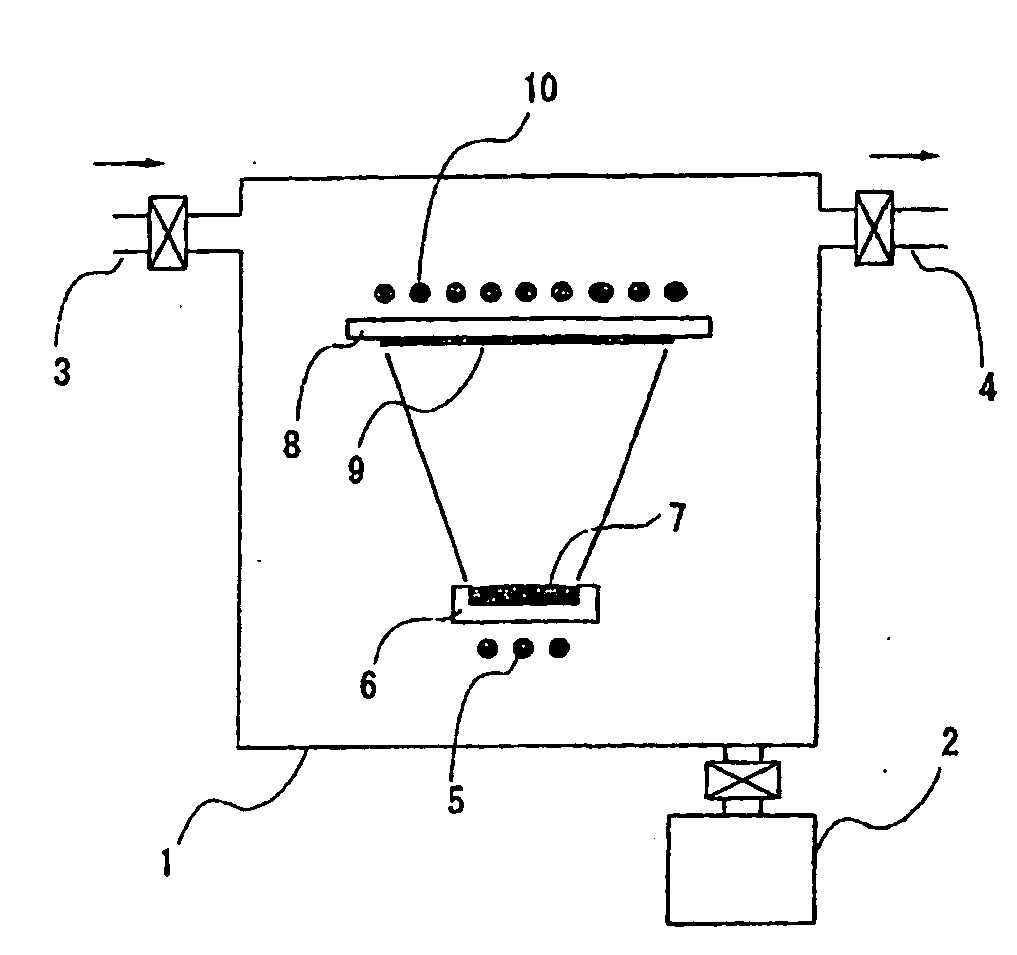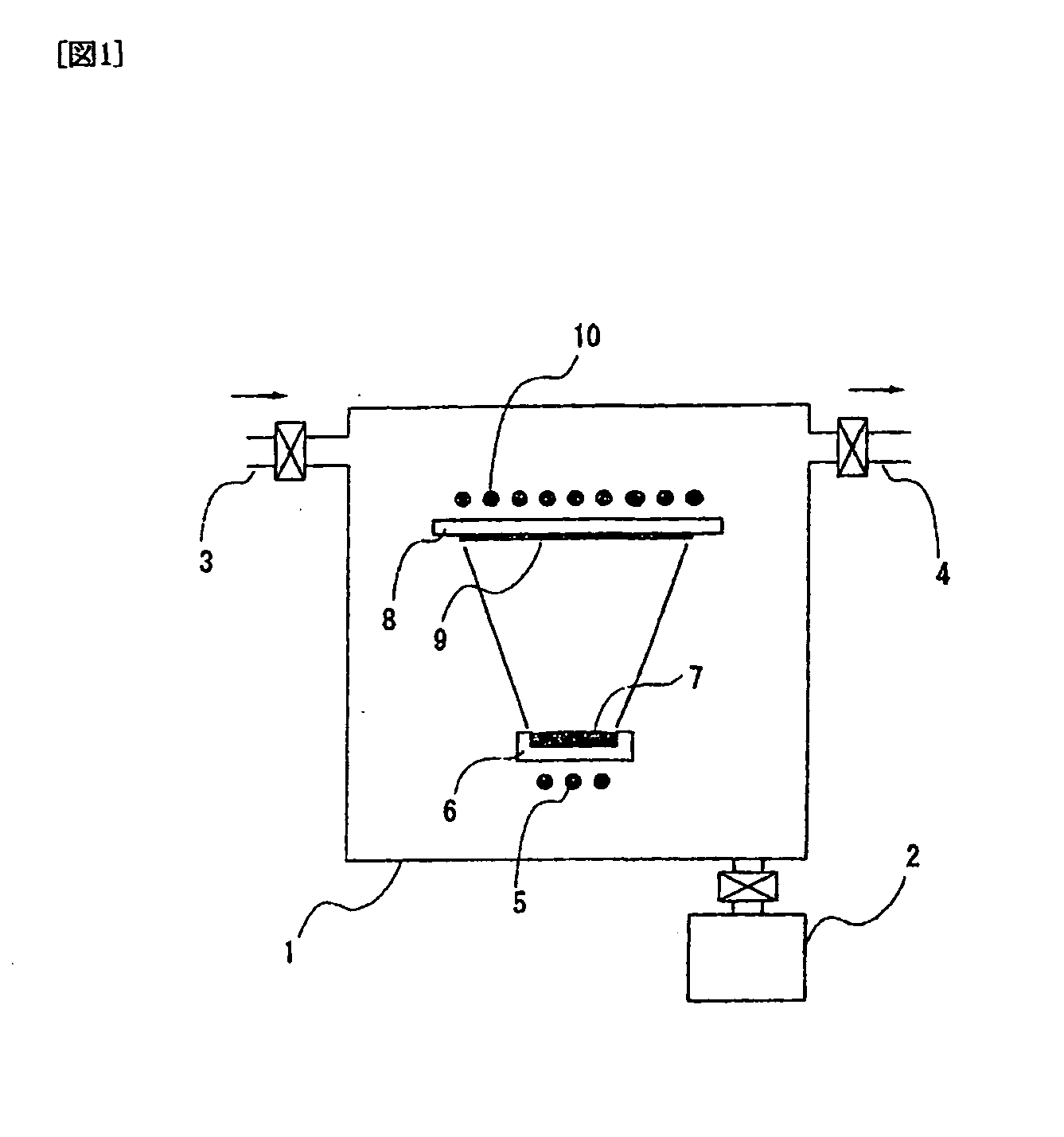Fullerene or nanotube, and method for producing fullerene or nanotube
a technology nanotube, which is applied in the direction of sustainable manufacturing/processing, instruments, and final product manufacturing, can solve the problems of using an evacuating machine, and achieve the effects of reducing production costs, restoring or improving the conductivity of fullerene or nanotube, and safe application
- Summary
- Abstract
- Description
- Claims
- Application Information
AI Technical Summary
Benefits of technology
Problems solved by technology
Method used
Image
Examples
example 1
Vapor Deposition in an Ultra-Clean Environment
[0175]An environment suitable for manufacturing a fullerene film according to the above-described condition appropriate for the production of highly conductive fullerenes was prepared using a system as shown in FIG. 1 where the degree of vacuum within vessel 1 was made 5×10−10 Torr (6.65×10−8 Pa). According to an API-MS machine connected to the vessel 1, it was found that the concentration of water at a site where a fullerene film would be formed was 3 ppt. A 50 mg of fullerenes C60 (Tokyo Chemical Industry) was placed in a molybdenum-made boat for vapor deposition, and the boat was heated at 500° C. for 1 hour so that a fullerene film having a thickness of about 0.4 μm was deposited on a substrate 8. Under an As-Depo state where the substrate temperature was 82° C., the measurement was made by applying a voltage of 2V between two terminals which resulted in the passage of current of 1.1 mA, and the conductivity was found to be 0.34 (Ωcm...
example 2
Vapor Deposition in an Ultra-Clean Environment
[0176]An environment suitable for manufacturing a fullerene film according to the above-described condition appropriate for the production of highly conductive fullerenes was prepared using a system as shown in FIG. 1. The vessel or chamber was baked at 150° C. for one week. As a result, the degree of vacuum within vessel 1 was found to be 10−11 Torr. According to an API-MS machine connected to the vessel 1, it was found that the concentration of water at a site where a fullerene film would be formed was 1 ppt or less. A 50 mg of fullerenes C60 (Tokyo Chemical Industry) was placed in a molybdenum-made boat for vapor deposition, and the boat was heated at 470° C. for 30 minutes so that a fullerene film having a thickness of about 0.1 μm was deposited on a substrate 8. Under an As-Depo state where the substrate temperature was 74° C., the measurement was made by applying a voltage of 0.2V between two terminals which resulted in the passage...
example 3
Recovery of Conductivity Via Co-Deposition and Inert Gas Heating in an Ultra-Clean Environment
[0177]An environment suitable for manufacturing a co-deposited film comprising fullerenes according to the above-described condition appropriate for the production of highly conductive fullerenes was prepared using a system as shown in FIG. 1. The vessel or chamber was baked at 150° C. for one week. As a result, the degree of vacuum within vessel 1 was found to be 10−11 Torr. According to an API-MS machine connected to the vessel 1, it was found that the concentration of water at a site where a fullerene film would be formed was 1 ppt or less. A 50 mg of fullerenes C60 (Tokyo Chemical Industry) and 50 mg of copper phthalocyanine were placed in a molybdenum-made boat for vapor deposition, and the boat was heated at 470° C. for 30 minutes so that a fullerene / copper phthalocyanine film having a thickness of about 0.1 μm was deposited on a substrate 8. Under an As-Depo state where the substrate...
PUM
| Property | Measurement | Unit |
|---|---|---|
| Temperature | aaaaa | aaaaa |
| Temperature | aaaaa | aaaaa |
| Temperature | aaaaa | aaaaa |
Abstract
Description
Claims
Application Information
 Login to View More
Login to View More - R&D
- Intellectual Property
- Life Sciences
- Materials
- Tech Scout
- Unparalleled Data Quality
- Higher Quality Content
- 60% Fewer Hallucinations
Browse by: Latest US Patents, China's latest patents, Technical Efficacy Thesaurus, Application Domain, Technology Topic, Popular Technical Reports.
© 2025 PatSnap. All rights reserved.Legal|Privacy policy|Modern Slavery Act Transparency Statement|Sitemap|About US| Contact US: help@patsnap.com



